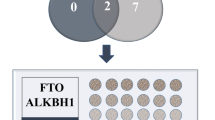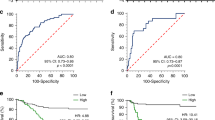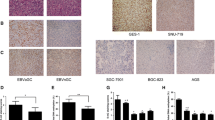Abstract
Gastric cancer (GC) is the third leading cause of cancer-related death worldwide. Very few therapeutic options are currently available in this neoplasia. The use of 5-Aza-2′-deoxycytidine (5-AZAdC) was approved for the treatment of myelodysplastic syndromes, and this drug can treat solid tumours at low doses. Epigenetic manipulation of GC cell lines is a useful tool to better understand gene expression regulatory mechanisms for clinical applications. Therefore, we compared the gene expression profile of 5-AZAdC-treated and untreated GC cell lines by a microarray assay. Among the genes identified in this analysis, we selected NRN1 and TNFAIP3 to be evaluated for gene expression by RT-qPCR and DNA methylation by bisulfite DNA next-generation sequencing in 43 and 52 pairs of GC and adjacent non-neoplastic tissue samples, respectively. We identified 83 candidate genes modulated by DNA methylation in GC cell lines. Increased expression of NRN1 and TNFAIP3 was associated with advanced tumours (P < 0.05). We showed that increased NRN1 and TNFAIP3 expression seems to be regulated by DNA demethylation in GC samples: inverse correlations between the mRNA and DNA methylation levels in the promoter of NRN1 (P < 0.05) and the intron of TNFAIP3 (P < 0.05) were detected. Reduced NRN1 promoter methylation was associated with III/IV TNM stage tumours (P = 0.03) and the presence of Helicobacter pylori infection (P = 0.02). The identification of demethylated activated genes in GC may be useful in clinical practice, stratifying patients who are less likely to benefit from 5-AZAdC-based therapies.
Key messages
-
Higher expression of NRN1 and TNFAIP3 is associated with advanced gastric cancer (GC).
-
NRN1 promoter hypomethylation contributes to gene upregulation in advanced GC.
-
TNFAIP3 intronic-specific CpG site demethylation contributes to gene upregulation in GC.
-
These findings may be useful to stratify GC patients who are less likely to benefit from DNA demethylating-based therapies.



Similar content being viewed by others
References
Bray F, Ferlay J, Soerjomataram I, Siegel RL, Torre LA, Jemal A (2018) Global cancer statistics 2018: GLOBOCAN estimates of incidence and mortality worldwide for 36 cancers in 185 countries. CA Cancer J Clin 68(6):394–424
Ito S, Ohashi Y, Sasako M (2018) Survival after recurrence in patients with gastric cancer who receive S-1 adjuvant chemotherapy: exploratory analysis of the ACTS-GC trial. BMC Cancer 18(1):449
Jin Z, Jiang W, Wang L (2015) Biomarkers for gastric cancer: progression in early diagnosis and prognosis (review). Oncol Lett 9(4):1502–1508
Breitling R, Armengaud P, Amtmann A, Herzyk P (2004) Rank products: a simple, yet powerful, new method to detect differentially regulated genes in replicated microarray experiments. FEBS Lett 573(1–3):83–92
(2014) Comprehensive molecular characterization of gastric adenocarcinoma. Nature 513(7517): 202–9
Zhao L, Duan YT, Lu P, Zhang ZJ, Zheng XK, Wang JL, Feng WS (2018) Epigenetic targets and their inhibitors in Cancer therapy. Curr Top Med Chem 18(28):2395–2419
Leal MF, Martins do Nascimento JL, da Silva CE, Vita Lamarao MF, Calcagno DQ, Khayat AS, Assumpcao PP, Cabral IR, de Arruda Cardoso Smith M, Burbano RR (2009) Establishment and conventional cytogenetic characterization of three gastric cancer cell lines. Cancer Genet Cytogenet 195(1):85–91
Wisnieski F, Calcagno DQ, Leal MF, Chen ES, Gigek CO, Santos LC, Pontes TB, Rasmussen LT, Payao SL, Assumpcao PP, Lourenco LG, Demachki S, Artigiani R, Burbano RR, Smith MC (2014) Differential expression of histone deacetylase and acetyltransferase genes in gastric cancer and their modulation by trichostatin a. Tumour Biol 35(7):6373–6381
Lauren P (1965) The two histological Main types of gastric carcinoma: diffuse and so-called intestinal-type carcinoma. An attempt at a Histo-clinical classification. Acta Pathol Microbiol Scand 64:31–49
Washington K (2010) 7th edition of the AJCC cancer staging manual: stomach. Ann Surg Oncol 17(12):3077–3079
Kolesnikov N, Hastings E, Keays M, Melnichuk O, Tang YA, Williams E, Dylag M, Kurbatova N, Brandizi M, Burdett T, Megy K, Pilicheva E, Rustici G, Tikhonov A, Parkinson H, Petryszak R, Sarkans U, Brazma A (2015) ArrayExpress update--simplifying data submissions. Nucleic Acids Res 43(Database issue):D1113–D1116
Benjamini Y, Hochberg Y (1995) Controlling the false discovery rate: a practical and powerful approach to multiple testing. J R Stat Soc Ser B Methodol 57:289–300
Wisnieski F, Calcagno DQ, Leal MF, dos Santos LC, Gigek Cde O, Chen ES, Pontes TB, Assumpcao PP, de Assumpcao MB, Demachki S, Burbano RR, Smith Mde A (2013) Reference genes for quantitative RT-PCR data in gastric tissues and cell lines. World J Gastroenterol 19(41):7121–7128
Li LC, Dahiya R (2002) MethPrimer: designing primers for methylation PCRs. Bioinformatics 18(11):1427–1431
Pabinger S, Ernst K, Pulverer W, Kallmeyer R, Valdes AM, Metrustry S, Katic D, Nuzzo A, Kriegner A, Vierlinger K, Weinhaeusel A (2016) Analysis and visualization tool for targeted amplicon bisulfite sequencing on ion torrent sequencers. PLoS One 11(7):e0160227
Krainer J, Weinhausel A, Hanak K, Pulverer W, Ozen S, Vierlinger K, Pabinger S (2019) EPIC-TABSAT: analysis tool for targeted bisulfite sequencing experiments and array-based methylation studies. Nucleic Acids Res 47(W1):W166–WW70
Krueger F, Andrews SR (2011) Bismark: a flexible aligner and methylation caller for bisulfite-Seq applications. Bioinformatics 27(11):1571–1572
Farlik M, Sheffield NC, Nuzzo A, Datlinger P, Schonegger A, Klughammer J, Bock C (2015) Single-cell DNA methylome sequencing and bioinformatic inference of epigenomic cell-state dynamics. Cell Rep 10(8):1386–1397
Lesurf R, Cotto KC, Wang G, Griffith M, Kasaian K, Jones SJ, Montgomery SB, Griffith OL (2016) ORegAnno 3.0: a community-driven resource for curated regulatory annotation. Nucleic Acids Res 44(D1):D126–D132
Hongchang Dong XL, Niu Y, Yu N, Gao R, Wang H, Yang L, Huang J (2018) Neuritin 1 expression in human normal tissues and its association with various human cancers. Int J Clin Exp Pathol 11(4):1956–1964
Zhang L, Zhao Y, Wang CG, Fei Z, Wang Y, Li L, Zhen HN (2011) Neuritin expression and its relation with proliferation, apoptosis, and angiogenesis in human astrocytoma. Med Oncol 28(3):907–912
Yuan M, Li Y, Zhong C, Niu J, Gong J (2015) Overexpression of neuritin in gastric cancer. Oncol Lett 10(6):3832–3836
Kitajima Y, Miyazaki K (2013) The critical impact of HIF-1a on gastric Cancer biology. Cancers (Basel) 5(1):15–26
Nardone G, Compare D, De Colibus P, de Nucci G, Rocco A (2007) Helicobacter pylori and epigenetic mechanisms underlying gastric carcinogenesis. Dig Dis 25(3):225–229
Nakajima T, Yamashita S, Maekita T, Niwa T, Nakazawa K, Ushijima T (2009) The presence of a methylation fingerprint of helicobacter pylori infection in human gastric mucosae. Int J Cancer 124(4):905–910
Codd JD, Salisbury JR, Packham G, Nicholson LJ (1999) A20 RNA expression is associated with undifferentiated nasopharyngeal carcinoma and poorly differentiated head and neck squamous cell carcinoma. J Pathol 187(5):549–555
Hjelmeland AB, Wu Q, Wickman S, Eyler C, Heddleston J, Shi Q, Lathia JD, Macswords J, Lee J, McLendon RE, Rich JN (2010) Targeting A20 decreases glioma stem cell survival and tumor growth. PLoS Biol 8(2):e1000319
Guo Q, Dong H, Liu X, Wang C, Liu N, Zhang J, Li B, Cao W, Ding T, Yang Z, Zhang X (2009) A20 is overexpressed in glioma cells and may serve as a potential therapeutic target. Expert Opin Ther Targets 13(7):733–741
Dong B, Lv G, Wang Q, Wei F, Bellail AC, Hao C, Wang G (2012) Targeting A20 enhances TRAIL-induced apoptosis in hepatocellular carcinoma cells. Biochem Biophys Res Commun 418(2):433–438
Wang Y, Wan M, Zhou Q, Wang H, Wang Z, Zhong X, Zhang L, Tai S, Cui Y (2015) The prognostic role of SOCS3 and A20 in human Cholangiocarcinoma. PLoS One 10(10):e0141165
Hadisaputri YE, Miyazaki T, Yokobori T, Sohda M, Sakai M, Ozawa D, Hara K, Honjo H, Kumakura Y, Kuwano H (2017) TNFAIP3 overexpression is an independent factor for poor survival in esophageal squamous cell carcinoma. Int J Oncol 50(3):1002–1010
Lee JH, Jung SM, Yang KM, Bae E, Ahn SG, Park JS, Seo D, Kim M, Ha J, Lee J, Kim JH, Kim JH, Ooshima A, Park J, Shin D, Lee YS, Lee S, van Loo G, Jeong J, Kim SJ, Park SH (2017) A20 promotes metastasis of aggressive basal-like breast cancers through multi-monoubiquitylation of Snail1. Nat Cell Biol 19(10):1260–1273
Honma K, Tsuzuki S, Nakagawa M, Tagawa H, Nakamura S, Morishima Y, Seto M (2009) TNFAIP3/A20 functions as a novel tumor suppressor gene in several subtypes of non-Hodgkin lymphomas. Blood 114(12):2467–2475
Ungerback J, Belenki D, Jawad ul-Hassan A, Fredrikson M, Fransen K, Elander N, Verma D, Soderkvist P (2012) Genetic variation and alterations of genes involved in NFkappaB/TNFAIP3- and NLRP3-inflammasome signaling affect susceptibility and outcome of colorectal cancer. Carcinogenesis 33(11):2126–2134
Opipari AW Jr, Hu HM, Yabkowitz R, Dixit VM (1992) The A20 zinc finger protein protects cells from tumor necrosis factor cytotoxicity. J Biol Chem 267(18):12424–12427
Boone DL, Turer EE, Lee EG, Ahmad RC, Wheeler MT, Tsui C, Hurley P, Chien M, Chai S, Hitotsumatsu O, McNally E, Pickart C, Ma A (2004) The ubiquitin-modifying enzyme A20 is required for termination of toll-like receptor responses. Nat Immunol 5(10):1052–1060
Vereecke L, Beyaert R, van Loo G (2009) The ubiquitin-editing enzyme A20 (TNFAIP3) is a central regulator of immunopathology. Trends Immunol 30(8):383–391
Lee E, Ouzounova M, Piranlioglu R, Ma MT, Guzel M, Marasco D, Chadli A, Gestwicki JE, Cowell JK, Wicha MS, Hassan KA, Korkaya H (2019) The pleiotropic effects of TNFalpha in breast cancer subtypes is regulated by TNFAIP3/A20. Oncogene 38(4):469–482
Maeda S, Otsuka M, Hirata Y, Mitsuno Y, Yoshida H, Shiratori Y, Masuho Y, Muramatsu M, Seki N, Omata M (2001) cDNA microarray analysis of helicobacter pylori-mediated alteration of gene expression in gastric cancer cells. Biochem Biophys Res Commun 284(2):443–449
Sun F, Ni Y, Zhu H, Fang J, Wang H, Xia J, Ding F, Shen H, Shao S (2018) microRNA-29a-3p, up-regulated in human gastric cells and tissues with H. pylori infection, promotes the migration of GES-1 cells via A20-mediated EMT pathway. Cell Physiol Biochem 51(3):1250–1263
Wertz IE, O'Rourke KM, Zhou H, Eby M, Aravind L, Seshagiri S, Wu P, Wiesmann C, Baker R, Boone DL, Ma A, Koonin EV, Dixit VM (2004) De-ubiquitination and ubiquitin ligase domains of A20 downregulate NF-kappaB signalling. Nature 430(7000):694–699
Lee EG, Boone DL, Chai S, Libby SL, Chien M, Lodolce JP, Ma A (2000) Failure to regulate TNF-induced NF-kappaB and cell death responses in A20-deficient mice. Science 289(5488):2350–2354
West AC, Tang K, Tye H, Yu L, Deng N, Najdovska M, Lin SJ, Balic JJ, Okochi-Takada E, McGuirk P, Keogh B, McCormack W, Bhathal PS, Reilly M, Oshima M, Ushijima T, Tan P, Jenkins BJ (2017) Identification of a TLR2-regulated gene signature associated with tumor cell growth in gastric cancer. Oncogene 36(36):5134–5144
Goodspeed A, Heiser LM, Gray JW, Costello JC (2016) Tumor-derived cell lines as molecular models of Cancer pharmacogenomics. Mol Cancer Res 14(1):3–13
Das T, Chen Z, Hendriks RW, Kool M (2018) A20/tumor necrosis factor alpha-induced protein 3 in immune cells controls development of autoinflammation and autoimmunity: lessons from mouse models. Front Immunol 9:104
Krikos A, Laherty CD, Dixit VM (1992) Transcriptional activation of the tumor necrosis factor alpha-inducible zinc finger protein, A20, is mediated by kappa B elements. J Biol Chem 267(25):17971–17976
Yuk JM, Kim TS, Kim SY, Lee HM, Han J, Dufour CR, Kim JK, Jin HS, Yang CS, Park KS, Lee CH, Kim JM, Kweon GR, Choi HS, Vanacker JM, Moore DD, Giguere V, Jo EK (2015) Orphan nuclear receptor ERRalpha controls macrophage metabolic signaling and A20 expression to negatively regulate TLR-induced inflammation. Immunity 43(1):80–91
Guerrero-Martinez JA, Reyes JC (2018) High expression of SMARCA4 or SMARCA2 is frequently associated with an opposite prognosis in cancer. Sci Rep 8(1):2043
Shi J, Whyte WA, Zepeda-Mendoza CJ, Milazzo JP, Shen C, Roe JS, Minder JL, Mercan F, Wang E, Eckersley-Maslin MA, Campbell AE, Kawaoka S, Shareef S, Zhu Z, Kendall J, Muhar M, Haslinger C, Yu M, Roeder RG, Wigler MH, Blobel GA, Zuber J, Spector DL, Young RA, Vakoc CR (2013) Role of SWI/SNF in acute leukemia maintenance and enhancer-mediated Myc regulation. Genes Dev 27(24):2648–2662
Acknowledgments
We are grateful to Brunno dos Santos Pereira, Renata Sanches de Almeida, and Camila Albuquerque Pinto for the help in sample collection and to Brunno dos Santos Pereira for the help in generating the final figures.
Funding
This study was supported by the Fundação de Amparo à Pesquisa do Estado de São Paulo (FAPESP; to FW, DQC, JCG, MFL, and MACS), the Conselho Nacional de Desenvolvimento Científico e Tecnológico (CNPq; to FW, DQC, JCG, RRB, and MACS), and Coordenação de Aperfeiçoamento de Pessoal de Nível Superior (CAPES; to COG and ACA).
Author information
Authors and Affiliations
Contributions
Conception and design: FW, MFL, RRB, and MACS. In vitro experiments: FW and DQ. Sample collection: FW, LCS, DQC, JCG, COG, ACA, ESC, PPA, LGL, and CHA. Pathological analysis: RA and SD. H. pylori diagnosis: LTR and SLMP. Molecular experiments: FW, LCS, DQC, JCG, COG, ACA, ESC, and MFL. Data analysis: FW, LCS, JCG, SP, and JK. Writing, review, and/or revision of the manuscript: all authors. Administrative, technical, or material support: MACS and RRB.
Corresponding authors
Ethics declarations
Conflict of interest
The authors declare that they have no conflict of interest.
Informed consent
The study was approved by medical ethics committee of each study center. Written informed consent was obtained from each patient.
Additional information
Publisher’s note
Springer Nature remains neutral with regard to jurisdictional claims in published maps and institutional affiliations.
Electronic supplementary material
Supplementary Fig. 1
GC cell line viability after 5-AZAdC treatment, Each point represents the mean ± standard error of three independent experiments. (PNG 1376 kb)
Supplementary Table 1
Primer sequences for DNA methylation analysis, *For target amplification, 25 ng of bisulfite-treated DNA was used in PCR reactions with Platinum™ Taq DNA Polymerase (Thermo Fisher Scientific, Waltham, MA, USA) (XLSX 10 kb)
Supplementary Table 2
List of 83 DEGs by comparing 5-AZAdC-treated and non-treated GC cell lines using de RP analysis. FC: fold change, FDR: false discovery rate (XLSX 12 kb)
Supplementary Table 3
Clinicopathological associations of NRN1 mRNA and DNA methylation levels. aAccording to the Lauren classification [9], bAccording to AJCC [10], c, dDetected in tumour samples as described previously [8], *Significant difference between groups by the Mann-Whitney test, n: number of samples. IQR: interquartile range (XLSX 13 kb)
Supplementary Table 4
Clinicopathological associations of TNFAIP3 mRNA and DNA methylation levels, aAccording to the Lauren classification [9], bAccording to AJCC [10], c, dDetected in tumour samples as described previously [8], *Significant difference between groups by Mann-Whitney test, n: number of samples. IQR: interquartile range (XLSX 15 kb)
Supplementary Table 5
Correlation between NRN1 mRNA and methylation levels in gastric tissue samples. (XLSX 13 kb)
Supplementary Table 6
Correlation between TNFAIP3 mRNA and methylation levels in GC tissue samples. (XLSX 15 kb)
Rights and permissions
About this article
Cite this article
Wisnieski, F., Santos, L.C., Calcagno, D.Q. et al. The impact of DNA demethylation on the upregulation of the NRN1 and TNFAIP3 genes associated with advanced gastric cancer. J Mol Med 98, 707–717 (2020). https://doi.org/10.1007/s00109-020-01902-1
Received:
Revised:
Accepted:
Published:
Issue Date:
DOI: https://doi.org/10.1007/s00109-020-01902-1




